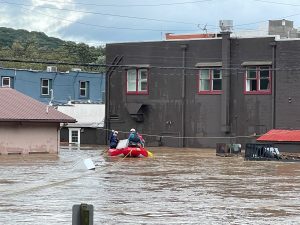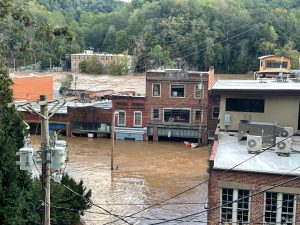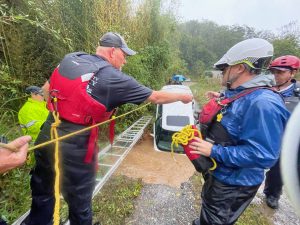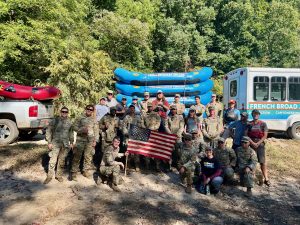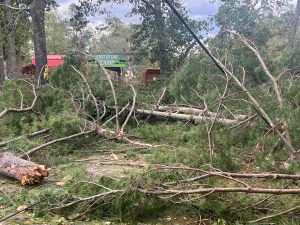North Carolina operators and vendors grapple with the impacts of Hurricane Helene in this two-part series.
Aerial adventure operators and vendors in North Carolina were among those impacted when Hurricane Helene unleashed horrific, devastating flooding in the western North Carolina mountains over three days in late September. The worst-hit areas around Asheville saw unimaginable amounts of water. The flooding wiped out some river towns, tearing homes and buildings from their foundations and sweeping away everything in its path.
This mountainous area is home to some of the most established outdoor and aerial adventure vendors and operators in the country. Among them are vendors Challenge Design Innovations and Challenge Towers, and adventure operators Navitat, French Broad Adventures, Asheville Adventure Center, and Boone Zip. All were impacted to some extent, and some may be changed forever.
The hurricane proved to be even more impactful than was forecast—and it was expected to be extremely fierce. As bad as the wind and rain were, their effect was compounded by several days of rain that preceded Helene, which left the ground saturated and the rivers above normal. The water—up to 24 inches of rain fell in some places, and more than 15 inches were recorded over a large stretch of the mountains—could do nothing but roar down even the tiniest of drainages. The French Broad River, which at one gauge averages about 1,700 cfm, flowed at a rate just over 100,000 cfm, on a par with Niagara Falls. Streams that were normally small enough to throw a stone across grew to half a mile wide.
The devastation caused by the wind and water overwhelmed the local infrastructure. Power was knocked out over a wide area, travel was cut off by washed-out bridges and downed trees. Some major roads, including I-40, remained closed for more than a month. The flooding wiped out campsites and trailer homes and created huge debris piles.
Close to 100 people in North Carolina, most of them in the hardest-hit areas, lost their lives. Countless others were left without food or shelter, and for weeks had limited options for either. It was three weeks before power was mostly restored. Roads have largely been patched temporarily, but it will be years before all are fully repaired.
The rivers themselves have been radically and permanently changed. North Carolina’s rivers have been famous for their whitewater rapids. Most of these revered spots are gone. River companies are at risk for survival.
Because of the widespread disruption to transportation, power, and communications, each isolated community had to fend for itself. Typically, neighbors took care of neighbors, and communities set up their own relief efforts to supplement the help of FEMA and other governmental agencies. Construction companies patched roads, anyone with a chainsaw helped clear downed trees from homes, roads, driveways.
Over the longer term, people wonder how the region will recover. The tourism-dependent economy has been brought to a standstill, and as one person who spoke with API said, “a return to 100 percent normalcy within the next six months to a year is not realistic. It’s going to take a lot of time for many of these communities to rebuild.”
On the plus side, outside of the communities that were most affected by flooding, other locations and businesses have recovered quickly. On the downside, the message has been to stay away so that the recovery work can proceed. But to fully recover, the tourism economy needs tourists. Locals in and adjacent to the affected areas wonder: if the economy is shut down, how are we going to eat?
A Lesson for Business
Korey Hampton, co-owner of French Broad Adventures and board chair of the Association for Challenge Course Technology, offered a warning to all outdoor operators. She told API that while this disaster was indeed terrible, it won’t be the last to impact members of the industry. As people across the country and indeed the world have seen, weather is becoming more extreme, and extreme events are becoming more common. Operators have to be prepared for it.
“The mountains here were supposed to be disaster-proof,” Hampton said. “I have had a naive mentality that we were safe from wildfires and other threats.”
As a result, she added, “We are going to lose an astounding amount of money because we didn’t anticipate flooding. We all need to be prepared in logistical, financial, and insurance areas.”
We heard similar cautions from other operators, alongside remarkable tales of action and community service. With versatile vehicles and wilderness equipment, plus staff trained in emergency medical care, experience in talking to people and taking action during stressful activities, and armed with local knowledge, aerial adventure parks and their employees often played an outsized role in rescue and recovery efforts.
Here’s how it went down—the damage done, the immediate responses, and the long-term challenges—for several industry players, including French Broad Adventures, The Gorge, and the Adventure Center of Asheville.
(In part two of this series, we’ll share stories from Navitat, Sky Valley Zip Tours, and Challenge Towers / High Gravity Adventures about their experiences and recovery efforts in the aftermath of the hurricane.)
French Broad Adventures: Heroic Action
Of everyone in the affected area, Mitch and Korey Hampton, owners of French Broad Adventures, felt the impacts the most. Not so much because Helene damaged their properties, but because their expertise in swiftwater rescue was in constant demand for five weeks. In addition, the flooding left the French Broad River radically altered, and that will likely affect the park’s water adventures and canyoneering operations.
Just what adventures will remain was not completely clear, in part because the Hamptons have been too busy to look into it. However, with damage to the zip tour, MTB trails, and the river operations, the Hamptons quickly determined that French Broad won’t reopen until next spring.
As the only swiftwater rescue team in the area, it fell to the Hamptons to conduct (or at least attempt) the most difficult and dangerous water rescues. For several days, starting at 6:30 a.m. on Friday, Sept. 27, they spent nearly every daylight hour seeking to rescue people stranded in homes, hotels, and clinging to trees, bouncing from one perilous situation to another. And once the flooding receded, their efforts shifted to the recovery of the bodies of those who had perished. That difficult work went on, every day, for a month or more.
“We stepped up because we had skills that were valuable in the crisis we were faced with, and we already had an affiliation with (and the respect of) the relevant government agencies that could deploy us to help in the rescue and recovery efforts,” Hampton said.
The Hamptons’ rescue work was well chronicled in two USA Today articles on the immediate rescue work as well as the later recovery duty. These make compelling reading, which we highly recommend.
Hampton believes there are also bigger lessons to be learned by others in outdoor recreation “about how to best prepare for other disasters like this. Being prepared is paramount to the resilience it takes for your business to have a chance to survive.”
We already mentioned Hampton’s advice about logistics, finances, and insurance, which others cited as well. More advice: If you have an emergency action plan—and you should—contact the emergency service organizations in your area and bring them out to your site. Help them understand how to reach different parts of your course, so that they know what’s involved in the event of a rescue. “Having a relationship with all the emergency response teams was critical,” she said, in working with other rescue/emergency organizations.
Another discovery was that aerial adventure staff have a lot of the skill sets it takes to respond in an emergency. “Our staff know how to handle a crisis. As guides in the outdoor environment, we’re more capable of responding to emergencies than most, and can stay cool calm and collected,” she said.
She experienced that first hand. On one of the first emergency calls, the task was to paddle a raft to a hotel that was flooded to the second floor and evacuate guests and staff via ladder. With raging waters swirling and boiling all the way, just reaching the hotel was an accomplishment. The Hamptons raised a 24-foot ladder from the raft to the second story, and Korey climbed up with life jackets for the evacuees.
One guy looked at the raft bobbing in the water, and at the ladder swaying unsteadily, and said, “I’m terrified, can I say that?” “And I said, ‘That’s absolutely OK,'” she recalled. “And I automatically gave the same speech I give in ground school.” Somewhat relieved, the trapped occupants descended to the raft and safety.
While French Broad will survive—”we’re a pretty stable company so we’ll stay open, but not to usual level,” Hampton said—she was more concerned for the staff. “We don’t really know how to help them. They are out of work, obviously, and are volunteering their time. But their income is gone, so they have had to scramble.
“Understanding unemployment rules is key,” she said. “How do we make sure they get unemployment and FEMA assistance?”
French Broad also created a gofundme (as some other operators have) to crowdfund in the wake of the disaster. The question then becomes: How to disburse the contributions? Who deserves some of it, and how much?
While all that helps in the short run, it may well be “a couple of years at least” before business returns to normal. The downtown area of Marshall, where French Broad is located, was washed away. “It will take time for the tourist economy to return to normal, so a lot of my staff might move away and not come back,” Hampton said. “Can I incentivize them to stay? What can I realistically offer them?”
Support French Broad Adventures staff.
The Gorge: Staff to the Rescue
While The Gorge sustained some damage, “we are reopening as soon as we possibly can,” Abby Burt of the management team Applied Adventure told API. That’s because it’s the only remaining tourism driver for the town of Saluda, “a sweet little, small town with everything you’d expect in a North Carolina mountain town,” as Burt describes it. “So that motivates us in a really big way to be there for the community.”
The Green River, which created and runs through the eponymous Gorge, rose far higher than anyone could have ever expected. “There were a number of tubing businesses down there and all of their infrastructure is entirely gone,” Burt said. The local hydropower station, which controls the flow of water into the Green River Gorge, was “massively destroyed,” she added.
Many homes were impacted as well. There are small communities along the river, and one of the course managers of The Gorge, Kris Yarbrough, lives in one. The two roads along the river were flooded and washed out in some areas, cutting these communities off. Those living closest to the river were forced to retreat to higher ground for shelter. But there was no easy way to get food and water to these communities, or to get the residents out.
Yarbrough and his fiancée had evacuated to higher ground to stay with friends—”he’s a planner and risk manager, risk management is where we live,” said Burt—before the hurricane hit. After the storm passed, Yarbrough and other staff members, several of whom live in employee housing at The Gorge, geared up to check on Yarbrough’s home and offer assistance to residents who had stayed in place.
At the same time, The Gorge owners Tim and Sara Bell were surveying the damage to the facilities, and they intercepted a FEMA team from New York City and some U.S. Border Patrol agents from Maine who were providing protection. The search and rescue team was seeking a way to reach the stranded communities; trails from The Gorge proved the most accessible route—accessible being a 45-minute hike on incredibly steep terrain that dropped 1,100 feet in elevation, on trails that were washed out and treacherous. (The trail system remained a key entry and egress point for weeks, providing a supply route for gas, food, and water, even after the road on one side of the river reopened.)
Yarbrough and several guides led the rescue team down to the river, hiking through mud, debris, and dangerous paths, to reach isolated homes. Roady Zocklein, The Gorge operations manager, handled the up-top radio communication (phones had been knocked out, remember) and rallied the staff.
The Gorge team members helped the rescue team connect with stranded residents and aided the evacuation. “They were able to say, ‘so and so lives at that house. We need to go check on that house,'” Burt said. “They split up into teams and went door to door to get people out, including quite a few elderly folks.” In all, 27 people were brought up the trail and then airlifted to safety.
In recognition of their efforts, Yarbrough and guides Josh Newton and Boden Enochs were awarded U.S. Border Patrol patches—a rare honor for civilians.
Adventure Center of Asheville: Welcome, Campers!
At the Adventure Center, owner Jeff Greiner was relieved to see his zip lines and bike trails survived Helene relatively well. Twenty or so trees blocked the access road, and hundreds of trees came down. But much of the aerial adventure course and the first half of the zip tour were mostly untouched.
The second half of the tour, as well as the bike trails and forest generally, were less fortunate. “None of the trees that were part of the course fell, but trees fell on our bridges, trees fell into our course,” Greiner said. The Center was able to reopen a few weeks after the storm passed on a limited basis, and without much in the way of traffic. “We have kind of an express zip line,” he said, and all but one trail on the aerial course.
Greiner’s first concern, though, was for his staff. He held a team meeting to see how everybody was doing; three employees had been hit hard, including one who lost his house.
To help them and others who had lost property and belongings, the Center put out a call to the local community and to past visitors and other operators in the adventure industry for specific items: “here’s what they lost, here’s their size.”
Beyond that, Greiner said, “We also asked our employees who wanted to work. Many of them were also dealing with the trauma of what was going on in their own personal lives.” Those who were willing and able spent two weeks cleaning up the grounds, hauling debris and clearing the courses. The goal was “to get it to look like an oasis,” Greiner said, where people who’d been dealing with the trauma and impacts of Helene could escape for some recreation.
The staff also suggested that the Center create a version of its summer camp, since the schools were closed and parents needed to focus on their recovery efforts. “We pulled that together very quickly,” Greiner said. “Some of our counselors were teachers and they were not in school, so they volunteered to help out. Other staff who wanted to work joined in, and we were able to open up for two weeks of camp” before schools reopened. With the price set at half the summer camp rate, about 50 families took advantage of the opportunity.
Longer term, the situation is less clear. “Your staff wonder, are you going to survive? Should I be looking for other work? Even if they’re not asking you that, they’re potentially thinking that,” Greiner said. And Greiner could not make any promises. Instead, he said, “We’re gonna have to figure this out together. I would have much rather come out and said we’re good.”
“Our big challenge right now is trying to get SBA loans or insurance money, and working through that process is a handful,” he said. While the Center had business interruption insurance, the devil is in the details. Was the course damage due to wind or flooding? If the latter, it wasn’t covered, and determining what damage was due to wind or water takes time.
“You just hope that the team that guided us in getting our insurance helped us dot all the I’s and cross all the t’s. The lesson is, it’s definitely tedious to read through all the paperwork, but you have to do it. The details definitely matter,” he noted.
In the interim, Greiner dug into the Center’s and his own personal savings to keep the payroll going, even though visits have been a fraction of normal.
Another issue: refunds. “We reached out to our guests that were booked and gave them three options—a refund, a credit, or a donation. There were definitely a lot of folks who were generous and did donations, and then we had a lot that did credits, and a few needed refunds.
Greiner operates at other locations in North Carolina where Helene’s impacts were minor, but these locations were down, too, “40 percent to 60 percent from what they normally would be in October because there was that broad sense of ‘we should stay away from there and we don’t want to get in the way.'” That drop in visitation was typical for most businesses across the western part of the state.
And that’s another lesson from Helene. “Any kind of bad news—a highway that’s blocked, that collapses, whatever, all those things can lead people to think, oh, I can’t get to the mountains of Colorado because a road in Denver shut down,” Greiner said.
Despite all the obstacles, Greiner remains positive. “We’re nervous, but optimistic that we’re a resilient team and we’ll find a way. One thing Covid gave us was a new sense of resilience, that this too shall pass. That’s a big part of where my heart is right now.”
Support Adventure Center staff by selecting “Gifts, Memberships, and Donations,” from the menu.
In the next article in this two-part series, we will share the stories of three more operators and vendors grappling with the impacts of Hurricane Helene. These include Navitat Canopy Adventure, Sky Valley Zip Tours, and Challenge Towers / High Gravity Adventures.
“I had three bridges that I’ve built because we also do electric ATV tours,” said Sky Valley owner / operator Jack Sharp. “One bridge, unbelievably, did not get touched by the water. But two of them, I watched them go down the river. These steel and aluminum bridges just floated down like they were rafts…”



